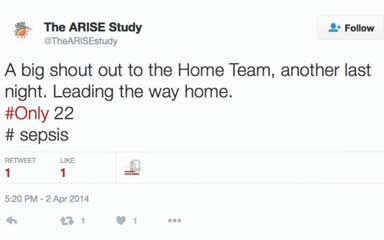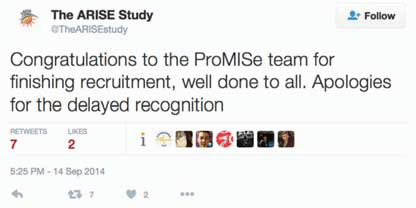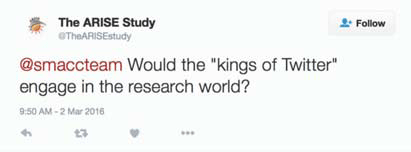INTRODUCTION
Advocates of evidence-based medicine (EBM) continue to mourn the sluggish pace of knowledge translation. The assimilation of research findings into medical practice often takes decades; estimates of the lag time between journal submission and use in routine practice cluster around 17 to 23 years.Reference Morris, Wooding and Grant 1 Reducing the time to the integration of accepted knowledge has been an objective of many professional organizations and academic institutions with varying degrees of success.
A recent Canadian Journal of Emergency Medicine (CJEM) editorial reviewed how the Free Open Access Medical education (FOAM or #FOAMed) movement is disrupting communication within emergency medicine.Reference Thoma, Mohindra and Artz 2 The impact on knowledge translation by social media-based platforms (such as blogs and podcasts) continues to grow globally.
In this second editorial, we discuss the promise and potential pitfalls of social media with regards to the dissemination and critical appraisal of the medical literature. If harnessed effectively, we believe that the FOAM movement has the potential to engage the medical community in rapid and effective knowledge translation that will enhance patient care.
Much ado about FOAM: Concerns regarding the quality of resources and rapid translation of knowledge
FOAM’s low barrier of entry acts as a double-edged sword: although content producers are able to publish analyses of recently published literature quickly, they do not necessarily undergo the editorial oversight required of traditional publications. Tools for evaluating the quality of these secondary resources are emerging (e.g., ALiEM AIR SeriesReference Lin, Joshi and Grock 3 and AIR Score,Reference Chan, Grock and Paddock 4 METRIQ,Reference Chan, Thoma and Krishnan 5 SMiReference Thoma, Sanders and Lin 6 ) but may take time to be adopted into widespread use.
The lack of traditional editorial and peer-review is one of the primary academic criticisms of most FOAM resources.Reference Brabazon 7 Some blogs incorporate variants of editorial supervision and prepublication peer review into their practice to increase their scholarly credibility,Reference Thoma, Chan and Desouza 8 , Reference Sidalak, Purdy and Luckett-Gatopoulos 9 but these practices are far from standard. Even if online resources improve their pre-publication processes, traditional peer review still has many limitationsReference Smith 10 and has not been sufficient to safeguard against the propagation of bad science or even outright fraud.Reference Callaway 11
Critics voice concerns that trainees are unduly influenced by producers of online content.Reference Cameron 12 Learners may be able to quote blogs and podcasts without demonstrating an understanding of the primary literature. Prominent members of the online community could develop an outsized influence on clinical emergency medicine that could be harmful if and when they are wrong. Post-publication reviews can spot errors and misinterpretations, but these addenda are often found in the less-read comments sections or more ephemeral media (e.g., Twitter). Furthermore, because FOAM often relies on reanalyses of primary research and subsequent collateral FOAM insights, it may be serially misinterpreted en route to the bedside.
Although FOAM resources may decrease the time to knowledge integration, the criticisms of FOAM dissemination apply to traditional methods as well. Opinion leaders have always had a substantive impact on practice change.Reference Carpenter and Sherbino 13 , Reference Doumit, Gattellari and Grimshaw 14 The online community is far from the first to place its prominent members on pedestals – the outsized influence of medical opinion leaders can be traced back to Osler, if not Hippocrates. Academic instructors are right to insist that learners should develop a critical understanding of the literature before they integrate it in their practice.
Paradoxically, the increased speed of knowledge translation may raise concerns about new knowledge entering practice before safety and efficacy can be established.Reference Cameron 12 While all innovation starts with early adopters, speedy adoption may lead to the utilization of new evidence before debate and further study have been conducted. A single study may prove to be an anomaly, with the realization that these results are spurious only after further studies and higher-order evidence (e.g., meta-analyses). The effect of faster knowledge delivery, while likely beneficial, is not necessarily certain.
The future of evidence-based medicine
Since the push for teaching critical appraisal skills in the 1990s, most medical school and residency curricula have an obligatory EBM component. 15 , Reference Green 16 While teaching the end-user to read critically made sense, these curricular additions predated the dynamic and networking powers of the Internet. Traditional methods of critical appraisal (i.e., individual users personally appraising every piece of literature) may not be sufficient or even practical in the digital age due to the sheer volume of material produced. Fortunately, although the connectedness resulting from social media has contributed to the problem, it may also offer a solution.
Traditionally, the formal critical appraisal of literature that defined the era of EBM was conducted in relative isolation. Physicians read through a paper using a checklist, then decided whether it was applicable to their practice. Some congregated in small groups or local journal clubs to examine literature. Yet in this new age of instantaneous global communication, it makes little sense to ignore the insights and perspectives from the easily accessible, worldwide community of practice. With social media, we can do much more than passively digest information; online journal clubs and other constructivist platforms have emerged, harnessing our new connectivity to foster discussions between clinicians around the world.Reference Chan, Thoma and Radecki 17 Modern interconnectivity can move us from simply reading about novel therapies, treatments, and initiatives to discussing them with the scientists who developed them and content experts across the world. This engagement between scientists and learned audience members will keep the scientific community vibrant. Critical participation is key to EBM in the age of knowledge translation facilitated by social media.
This participatory approach to the evidence not only encourages a sophisticated level of learning, but also offers the potential for the co-construction of knowledge between end-user clinicians who take an active, participatory role and the scientists who are using novel and engaging methods to effectively disseminate their key findings in a timely manner.
In addition to requiring traditional critical appraisal skills, we propose that these innovations have led to the evolution of several new types of scholars who will impact the translation of literature (Figure 1).

Figure 1 Three Types of Scholars for a New Era of Evidence-Based Medicine.
How to get started
Box 1 provides some introductory primers for readers who are new to FOAM and social media resources.
Box 1 Articles that can serve as primers for those new to FOAM and social media engagement
Weingart SD, Thoma B. The online hierarchy of needs: a beginner’s guide to medical social media and FOAM. Emerg Med Australas EMA 2015;27(1):5, doi:10.1111/1742-6723.12361.
Duque L. How academics and researchers can get more out of social media; 2016. Available at: https://hbr.org/2016/06/how-academics-and-researchers-can-get-more-out-of-social-media (accessed 9 July 2016).
Shemer A. Digital Pedagogy Lab. Beyond academic Twitter: social media and the evolution of scholarly publication; 2016. Available at: http://www.digitalpedagogylab.com/hybridped/beyond-academic-twitter/ (accessed 15 July 2016).
Thoma B, Joshi N, Trueger NS, et al. Five strategies to effectively use online resources in emergency medicine. Ann Emerg Med 2014;64(4):392-5, doi:10.1016/j.annemergmed.2014.05.029.
Melvin L, Chan T. Using Twitter in clinical education and practice. J Grad Med Educ 2014;6:581-2, doi:10.1136/bmjopen-2013-002988.3.
Choo EK, Ranney ML, Chan TM, et al. Twitter as a tool for communication and knowledge exchange in academic medicine: a guide for skeptics and novices. Med Teach 2015;37(5):411-6, doi:10.3109/0142159X.2014.993371.
Ultimately, we believe that active engagement is the most important thing to foster in the readers and writers of CJEM. So, whether you are a clinician who can help critique and discuss research, a scientist who can help work and interact with clinicians and the public, or an educator interested in helping translate another’s work, the key to increased quality of online dissemination is for everyone to participate.
Box 2 lists case studies of successes that we have observed online, which may provide examples for how they might interact with others online.
Box 2 Case Studies
Critical Clinicians
Critical clinicians have been amongst us for a while. For example, the Best Evidence for Emergency Medicine (BEEM) Group has been assisting with knowledge translation by creating continuing medical education courses to teach practicing physicians about the most relevant literature for over a decade.Reference Duque 18 ,19 Newer examples that started in the FOAM community include physicians like Ryan Radecki (EM Literature of Note) and Rory Spiegel (EM Nerd), who make use of blogs and podcasts to share their critical appraisals of the latest literature.
Translational Teachers
Translational teachers now exist within the online world as well. Dr. Ken Milne, a rural emergency physician, publishes The Skeptic’s Guide to Emergency Medicine 20 HOP (Hot Off the Press) series to engage directly with scientists to assist in the translation of their work.21 Similarly, the CanadiEM.org website has frequently published infographics disseminating the results of studies published in the Canadian Journal of Emergency Medicine.
Interactive Investigators
Interactive investigators are also becoming increasingly prevalent. Within Canada, University of Ottawa’s Emergency Medicine group is an active department that regularly features novel knowledge translation and dissemination strategies. Under the leadership of Dr. Hans Rosenberg, this group has an active online social media presence on various platforms, including their blog (http://emottawa.blogspot.ca/), Twitter (@EmergMedOttawa), and Facebook (https://www.facebook.com/EmergencyMedicineOttawa/). Some scientists within that group, such as the prolific Dr. Ian Stiell (@EMO_Daddy), regularly engage with colleagues via these avenues.22
More recently, major research studies have also begun engaging physicians, recruitment centres, and readers via social media accounts. The ARISE study team (@ARISEstudy) managed a Twitter account dedicated to their multicentred randomized trial of early goal directed therapy versus usual care for patients with severe sepsis. The social media account for this study was first established to engage with physicians recruiting for the study (see figure 2) and continues to engage with other Twitter users and FOAM participants to bridge the critical steps of knowledge translation nearly two years after the publication of their primary findings.
Via this account, the research team has highlighted lectures and panels at conferences, engages with FOAM commentators, clinician colleagues, chats with clinicians at the bedside, and regularly tweets about related papers (e.g., ProMISe, as depicted in figure 3).
Figure 2. A tweet from the ARISE study Twitter account on 2014-04-02, at 20:20.

Figure 3. A tweet from the ARISE study Twitter account on 2014-09-14, at 20:25.
This account also reaches out to FOAM participants and commentators to arrange podcasts, retweet blogs about their study, and engage actively with stakeholders.
Figure 4. A tweet from the ARISE Study Twitter account on 2016-03-02, at 12:50.
The influence of these scholars on emergency medicine research
As the online world continues to play an increasingly large role in emergency medicine education, researchers will need to adjust to this reality. Critical clinicians use online platforms with increasingly frequency, and emergency medicine researchers should anticipate (and hope) that their publications will be discussed and debated on public forums. Not all scientists will be comfortable engaging with these clinicians or promoting their research. We suggest that they invite a Translational teacher to assist with their work. Collaborations with those possessing specialized skills in developing communication strategies for audience engagement, for instance, might provide scientists with insights on how to increase the reach of their research findings. Journals that foster their own translational teachers, as CJEM has done with the SGEM HOP podcasts and CanadiEM infographics, are more likely to become increasingly attractive places to publish for research groups that do not have their own talent in these areas.
LIMITATIONS
These new breeds of scholars will face limitations and pitfalls. Critical clinicians will need to gain credibility and visibility in the online community if their reviews are to have an impact. Translational teachers are at risk of being biased towards the researchers with whom they work, potentially decreasing the acceptability of the resources that they produce. Interactive investigators are likely to struggle to maintain a high research profile while remaining accessible and to ensure that their research is responsive to the feedback of the online community, given the dramatically different timelines of social media discussions and research publications. Finally, the potential for the growth of these new types of scholars will be stifled if the traditional reward structures of academic and community medical practice are unable to adapt to the recognition of their unique and valuable contributions to scholarship.
As the new roles for social media become defined, there will be conflict and overlap between the demands of expertise in each subfield. New scholars may find that the demands of knowledge translation and communication compete with research and clinical practice. There is only a finite amount of time, effort, and skill. So, a team-based approach, with multiple collaborators taking on different roles will likely be the way forward.
CONCLUSION
There will always be a risk in the adoption of any new finding that subsequent research will demonstrate unexpected fallibilities. Conversely, the delayed introduction of a new technique or system may cause unnecessary patient harm. The emergence of critical clinicians, translational teachers, and interactive investigators will not make these dilemmas any less likely; by incorporating a broader community with new perspectives and diverse skills, we have suggested a methodology to more safely reduce the knowledge translation and implementation gap. Let debates take place in open and public forums, rather than the isolated circles of individual clinicians or local groups. Engagement and participation can usher in a new era of transparency around clinical decision-making, knowledge integration, and evidence-based practice.
Competing interests: None declared.



